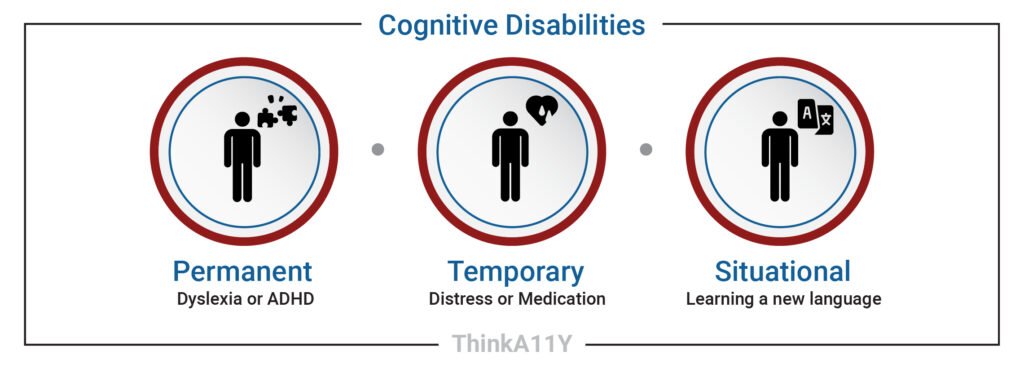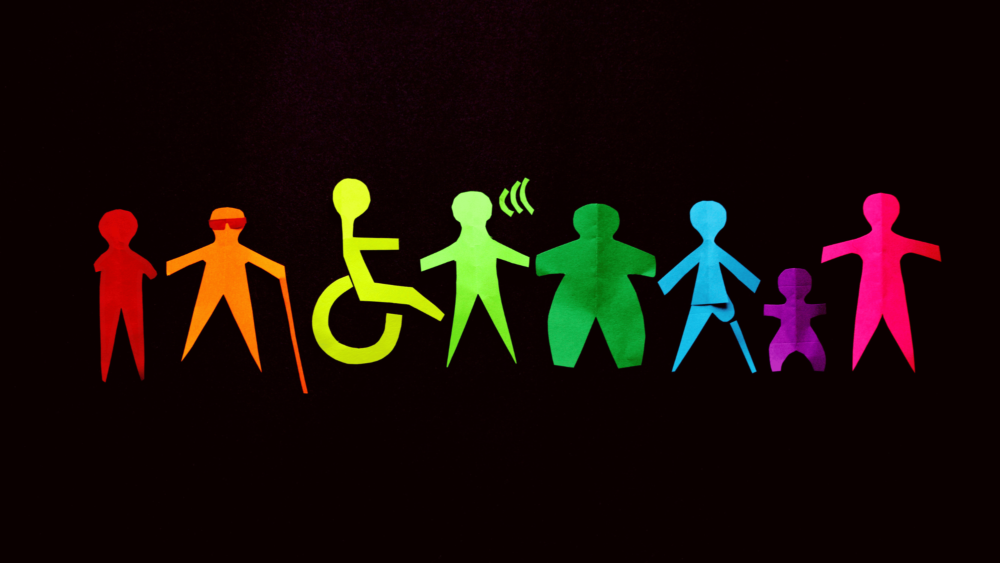Introduction
Accessibility is not just for people with disabilities, it is for everyone.
Many of us may find ourselves in temporary or situational limitations on how we use and access content on the web.
By creating solutions for users with a permanent disability, we are also helping users with temporary, situational disabilities or users with changing abilities due to age to benefit.
Four major categories of disabilities affect people accessing the web. Let’s discuss the permanent, temporary, and situational disabilities in each type.
Visual

Fig.1 – Vision Impairments – Examples illustrating Permanent (Blindness or Low vision), Temporary (Recovering from eye surgery), and Situational limitations (Bright light sensitivity).
Permanent Visual disabilities
- Low vision – mild to moderate vision loss in one or both eyes.
- Complete Blindness – uncorrectable vision loss in both eyes.
- Color Blindness – the inability to distinguish a few colors or the inability to perceive any color.
- Due to aging, illness – low vision or a permanent loss of vision due to aging or illness. Example Glaucoma.
Temporary Visual Disabilities
Some people may experience temporary visual impairments due to medications, accidents, or recovering from eye surgery.
Situational Visual Disability
Some visual impairments can be situational like
- Extreme Brightness – under bright sunlight.
- High Light Sensitivity – dilated eyes after the eye test.
- A situation like reading without contact lenses or glasses.
Auditory

Fig.2 – Auditory Impairments – Examples illustrating Permanent(Deafness or Hard of Hearing), Temporary (Ear pain or ear infection), Situational limitations (Accessing audio-visuals in train)
Permanent Auditory Impairment
- Hard of hearing – mild or moderate hearing loss in one or both ears.
- Deafness – substantial, uncorrectable loss of hearing in both ears.
- Deaf-blindness – substantial, uncorrectable hearing and vision loss.
Temporary Auditory Impairments
Examples of temporary hearing difficulty may include
- Ear pain or ear infection
- Recovering from an ear surgery
- Swimmer’s ears
Situational Auditory limitations
Some of us may face situational auditory limitations in our day-to-day life. examples:
- Accessing audio-visual content like news videos, and TV series in crowded places like trains, and restaurants.
- Viewing a TV Series in a new language.
Motor

Fig.3 – Motor or Physical Disabilities – Examples illustrating Permanent (Missing limbs), Temporary (Broken arm, Situational limitations (Parent working with one arm)
Motor disability is any physical condition that makes it difficult for a person to move around, coordinate, and control body movements. A physical disability could be inherited by birth or caused due to illness, an accidental injury, or aging.
Permanent Motor or Physical Impairment
A permanent physical condition that severely impacts someone from performing their daily routines like mobility, work, self-care, etc. Some examples include
- Involuntary movements, lack of sensation or motor control, or degeneration of muscles such as tremors, paralysis, muscular dystrophy, cerebral palsy, and Parkinson’s Disease.
- Lack of hand and eye coordination. such as “Reduced dexterity”.
- Joint disorders, chronic pain of joints and muscles that impedes movement, and missing limbs. such as arthritis, rheumatism, and amputation.
Temporary Physical Impairment
Inability to perform some physical tasks for a short period.
- Accidental injury – broken arm or leg
- limitations to move after surgery.
Situational Physical Limitations
Example of situational disability
- A parent working with a baby in one arm.
Cognitive

Fig.4 – Cognitive Disabilities – Examples illustrating Permanent (Dyslexia or ADHD), Temporary (Distress or Medication), Situational limitations (Learning a new Language)
Cognitive disabilities cover a wide spectrum of conditions and disorders which may include memory, learning, language, neurological, behavioral, or mental health disorders.
Cognitive disabilities may affect any part of the nervous system which has a significant impact on how well people hear, see, speak, and move, how well they perceive and understand information. However, cognitive disabilities do not necessarily reflect or impact the intelligence of a person.
Permanent Cognitive Disabilities
- Inability to focus on a single task, being easily distracted, or having short attention spans. Example: ADHD – Attention deficit hyperactivity disorder
- Learning, Perceptual Disabilities – involves difficulty processing auditory, visual, or other sensory information. Examples include:
Dyslexia – difficulty in reading,
Dysgraphia – difficulty in writing,
Dyscalculia – difficulty in processing numbers. - Lack of interaction abilities, restricted habits, and impaired social interaction. Examples include:
ASD – Autism spectrum disorder,
PDD – Pervasive developmental disorder. - Mental health disabilities – Some behavioral or mental health disorders may cause difficulty in focusing, processing information, or understanding it. Examples include:
Schizophrenia, Bipolar disorder, depression, delirium or hallucinations, paranoia. - Memory impairments – Decreased ability to think, remember, or recall which could be for a short period or long term.
Examples: Dementia and TGA-transient global amnesia. - Neurological Disorders – abnormal electrical activity in the brain, degenerative disorders related to the nervous system. Examples include:
Seizure disorders – Epilepsy, blackouts, and migraines could be triggered due to flickering visual content or audio signals at certain frequencies.
Multiple sclerosis – causes damage to nerve cells in the brain and spinal cord.
Temporary Cognitive Disabilities
Examples – Short-term conditions of anxiety and depression, migraines, etc.
Usually, the medications used to treat some mental, Psychological, and Neurological disorders have side effects like
- Blurred vision
- Hand tremors
- Difficulty to recall or remember
Situational Cognitive Disabilities
Examples include:
- Difficulty in focusing due to a headache.
- Stressful day
- Learning a new language
